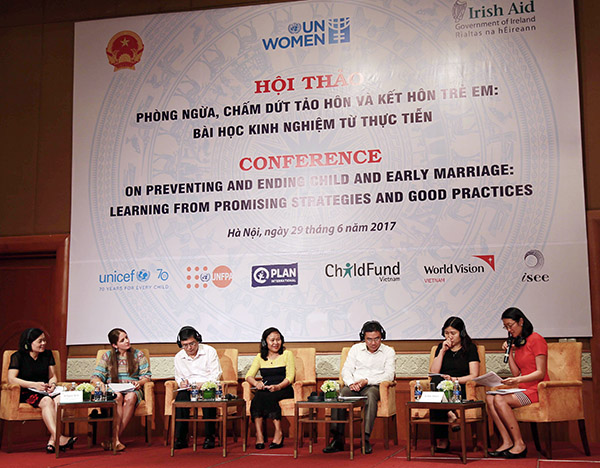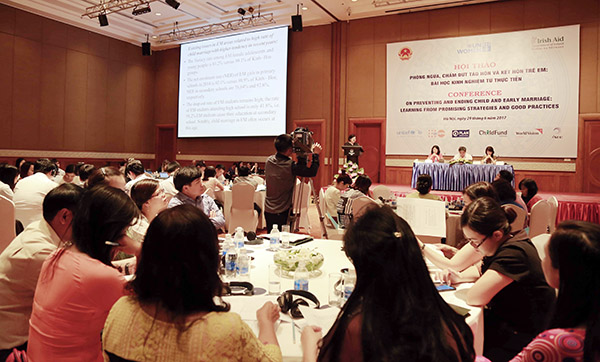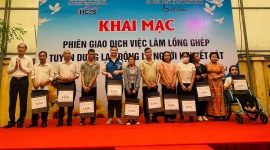11% of women in Vietnam are married before legal age
That is the information at the National Conference on Child and Early Marriage organized by the Committee on Ethnic Minority Affairs (CEMA) and UN Women, UNICEF, UNFPA, non-governmental organizations (World Vision, Plan International, ChildFund, iSEE) with support of Irish Aid and other funds, will also identify support needed to make commitments a reality in Ha Noi, June 29, 2017.
Jointly the conference have more than 100 experts from international organizations, governmental agencies, local organizations and academia have gathered in Ha Noi to discuss national and international experiences, effective strategies and interventions, and policy recommendations for Viet Nam to address child and early marriage.

Globally, 15 million girls marry every year before they reach there eigtheenth birthday. The 2030 Agenda for Sustainable Development sets Target 5.3 to eliminate all harmful practices including child, early and forced marriage by 2030. In Viet Nam, despite the Law on Marriage and Family setting the minimum legal age for marriage at 18 for women and 20 for men, 11% of women aged 20-49 years were married or in union before the age of 18. Moreover, there are disparities across regions and ethnic groups, and communities that are left behind socio-economic development and progress towards gender equality are struggling with higher prevalence of child marriage. The first national survey on social economic conditions of 53 ethnic minority groups conducted by the Committee on Ethnic Minority Affairs (CEMA) and the General Statistics Office in 2015 revealed that the average rate of child marriage among the 53 ethnic minority groups was as high as 26.6%, while some ethnic minority groups showing very high rate of early marriage ranging from 50 to 70%.
Opening the event, Mr. Ha Hung, Vice Minister of CEMA stressed that“early marriage has constrained girls’ opportunities for education, trainings as well as decent work in the future. Early marriage also leads to early pregnancy while the body hasn’t reached full growth, significantly affecting girls’ psychological and physical development. Early marriage also contributes to the risk of domestic violence and other forms of gender based violence.” Further, he added that “early marriage violates child rights. Overall, early marriage directly affects socio-economic development issues, making a vicious cycle of poverty among ethnic minority groups. This presents also a root cause degrading quality of human resources among ethnic minority areas.”

Speaking at the Conference on behalf of the UN agencies supporting the conference, Ms. Shoko Ishikawa, UN Women Country Representative in Viet Nam said “the key to breaking the cycle of child and early marriage lies with empowering and investing in women and girls. Every girl and woman at risk of or affected by child and early marriage must have equal access to quality services such as education and training, leagal and health, counselling, including for sexual and reproductive health, shelter and other social services. This requires all government bodies to ensure that their planning, budgeting, decision-making, policy making, and monitoring reflect the needs of girls and boys, and that investments in girls’ empowerment are prioritized in all areas and all sectors.”
Adding to the comments above, World Vision Viet Nam’s National Director Tran Thu Huyen on behalf of the non-governmental organizations supporting the conference emphasized the role of children in finding solutions for this issue. "It's very important to listen to children's perspectives on the root causes of child marriage and involve and empower them to participate in finding solutions to prevent and end child marriage, especially in ethnic minority groups," she said.
To ensure Viet Nam can develop a holistic and comprehensive approach to end child marriage, the National Conference on Child and Early Marriage examines and discusses lessons learned on key factors and barriers that impede effective interventions; and identify opportunities for multi-stakeholder collaboration and integration of child and early marriage interventions into development and socio-economic programmes in Viet Nam’s context, particularly in ethnic minority regions.
Recommendations of the conference on policy reform and future research to end child and early marriage in Viet Nam will be summarized and introduced to relavant national ministries and oganizations for their actions.
PV
-
 Minister Dao Ngoc Dung received the ASEAN’s General Secretary
24-04-2024 10:38 35
Minister Dao Ngoc Dung received the ASEAN’s General Secretary
24-04-2024 10:38 35 -
 Ha Nam province promotes career orientation for students
23-04-2024 14:28 49
Ha Nam province promotes career orientation for students
23-04-2024 14:28 49 -
 Hundreds of job opportunities for people with disabilities in Hanoi
17-04-2024 10:22 29
Hundreds of job opportunities for people with disabilities in Hanoi
17-04-2024 10:22 29
-
 Minister Dao Ngoc Dung received the Chairman of the Korea International Cooperation Agency
21-03-2024 14:14 48
Minister Dao Ngoc Dung received the Chairman of the Korea International Cooperation Agency
21-03-2024 14:14 48 -
 MoLISA proposing Japan to expand occupations to receive Vietnamese workers
18-03-2024 11:12 55
MoLISA proposing Japan to expand occupations to receive Vietnamese workers
18-03-2024 11:12 55 -
 Promote labour relations between Vietnam and Hungary
18-03-2024 09:55 15
Promote labour relations between Vietnam and Hungary
18-03-2024 09:55 15
English Review


Minister Dao Ngoc Dung received the ASEAN’s General Secretary
English Review | 24-04-2024 10:38 35







